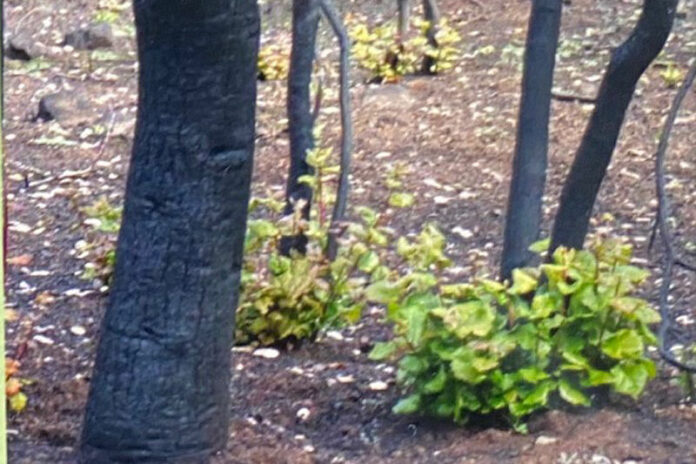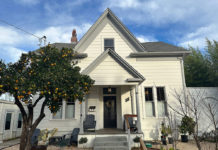
Trees and their accompanying undergrowth can be the victims, the drivers and the causes of catastrophic wildfires. At a webinar put on by the Sonoma County Farm Bureau these challenges were outlined and tips were given for homeowners to evaluate their own local plant life to eliminate those trees and plants that might be contributing to fire risk.
According to Cyndi Foreman from the Sonoma County Fire District, the problem starts with being “100 years behind on prescribed burning,” creating invasive fuels and lack of forest management, that is then compounded by insect infestation and Sudden Oak Death.
Fred Frye from Vintage Tree Care led the presentation on determining the health of your current trees.
“It’s simple math,” he said. “You have a dead or dry tree; you have more risk. (Also,) some species are more or less flammable than others. You’ll see me focus on risk perspectives you should be aware of, such as safety to structures, utilities, how to recognize those risks and then cross reference them with areas of highest concern.
“When you’re looking at trees, you should start at ground,” he said. “If you see mushrooms growing on or adjacent to the tree, that’s a flag. If we have a failure at the ground, then the biggest piece of tree is going to come down.
“If I’m looking at ground and see lifting or heaving soil, that tells me the tree is looking to fail,” he continued. “But, if looks ok, then I go up.
“Now inspect the structure by moving up from the ground level,” Frye said. “If I see multiple growths from one spot, or there’s a crack in the tree, if it’s not noticed the tree would have failed. If you see bulging or two limbs growing from the same place immediately you worry about failure.”
Frye stated other things to look for of concern include an asymmetric canopy, nesting cavities, branch shape and growth and structure. Fissures in the trunk or branches should also be a cause for concern, saying it creates a “predisposition to failure.”
Fungus can also be a concern, especially in relation to “pruning wounds” or areas where a branch has been removed.
“If I see fungus and then I look further up the tree and see a big wound, I know a lot of decay has happened,” he said. “The risk factor just went up.”
However, Frye pointed out that more often than not there is a continuum of symptoms that occur on a tree from top to bottom.
“Typically canopy symptoms coincide with the environment under the ground. If I go to the ground level, before I dig down to find the rot, I could see it had crown rot. It’s like reverse engineering. If I see above the canopy, and see die back, then I’m drawn to the ground level,” Frye said.
He also said to keep an eye out for “decomposers” or plants that indicate the tree is dying.
“If I see ‘salad’ (at the base of the tree) that is a red flag,” he said. “(The chances of that) tree going through your living room in high wind event is high.”
While homeowners should be aware of what to look for, it’s best have the final decision as to whether to remove a tree made by an International Society of Arboriculture (ISA) certified arborist or an American Society of Consulting Arborists (ASCA)-registered consulting arborist.
“Don’t wait until October and red flag warning to start walking your property,” Frye concluded.
What if the fires have already happened?
If you live in an area where the fires have already come through, you may also have questions about trees still standing but potentially damaged.
Gordon Mann, who has spent 40 years as a registered consulting tree and arborist and is a former volunteer firefighter.
“When we’re talking about how we measure damage to the tree, we’re really talking about how to evaluate trees that were fire damaged,” he said.
The starting point is determining the intensity of the burn.
Severe intensity burns occur where vegetation is more dense and pre-fire layers are deeper, and can occur in areas with high vegetation flammability such as stands with Bay Laurel or scrub. In a severe intensity burn, vegetation may be burned beyond recognition, most trees are killed and their foliage consumed (though trees may experience 100% mortality even if their leaves are not completely consumer) and recovery will require replanting or managing sprouts of hard woods and conifers.
A moderate intensity burn occurs in mixed stands with both oaks and conifers. In a moderate intensity burn, a mosaic of highly burned trees with lightly burned trees and scorched trees is created, with most trees damaged to some degree. Soil and canopy cover is reduced but eliminated. However, trunks may be burned on only one side making recovery rates high. Full recovery of the area will take three to 10 years.
A light intensity burn does not result in soil damage or massive tree death and occurs in areas of lower density vegetation. The ground cover recovers quickly and full recovery usually occurs in the first or second year.
According to Mann, when analyzing the damage to individual trees, you should asses the degree of wood consumption at the base of the tree and at any old injuries; the degree and percentage of scorch around the circumference of the trunk; the degree of scorch on the bark and branches, the degree of foliage consumed and the amount of re-sprouting at the base.
As a point of interest, according to Mann, most native California species will re-sprout following a fire.
The degree of tree survival is dependent on the size and density of trunks in the stands, the amount of scorched foliage, the percent of cambium killed around the circumference of the tree and the presence of old cavities from past fires.
Mann suggests homeowners wait as long as is safe and practicable before removing trees after a fire to see if they may survive. “Trees with even light sprouting can survive,” he said.







